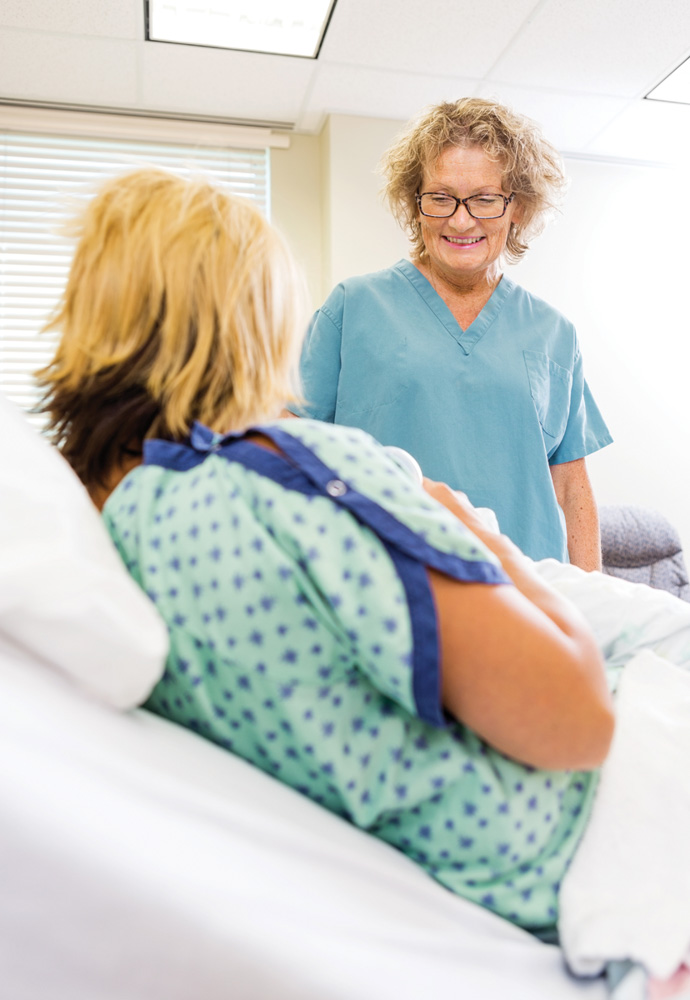Practiced for hundreds of years, midwifery is a medical profession that is present all over the world. Throughout that time, it has morphed into a refined and evidence-based childbirth method in which many people have expertise. The field, itself, includes both Certified Nursing Midwives who work with hospitals, as well as midwives who have their own practices.
Private Practice
Jill Roper of Flushing is owner of Compassionate Hands Birth Services in Grand Blanc. In 2012, she apprenticed under two different types of midwifery experts who taught her many skills; since then, she has delivered over 200 babies. Her overall goal, of course, is to walk a pregnant woman through a full-term pregnancy and make her feel as supported as possible. “My job is to empower women,” says Jill.
Through her dedication to women and mothers, she is leading by example to combat misconceptions about midwifery. “Midwives are experts in the physiology of birth,” says Jill. “We know that if you leave the mother alone, and you have walked her through the entire pregnancy, and she believes in her own body, she can do it. I see it every day.”
According to many of Jill’s “Mamas,” the main reason they choose a home birth is to feel comfortable and supported by the people she loves. Jill offers both home and water births. Her entire range of services includes all prenatal appointments, labor, birth, and various follow-ups during the first six weeks postpartum. She also provides a newborn hearing test and the congenital heart defect screening.
In addition to assisting with the childbirth, Jill is sure to educate the mothers about nutrition during the first trimester: advocating whole, raw, organic foods. She also encourages exercise and sexual activity, and provides informative handouts, websites, and everything is evidence-based to answer all of their questions. “The education is so important,” she adds.
During the first 12 weeks, Jill will see the mother at least once for an hour-long appointment, and by ten weeks, listens to the baby with a Doppler ultrasound and a fetoscope. She does offer one ultrasound scan at 20 weeks if the mother wants it; but midwives are trained to feel the baby through the belly with their hands, and she teaches mothers how to feel their babies. She also has a lab and offers blood testing.
“Birth is a natural part of the life cycle. Women need to trust and listen to their own bodies.”
JILL ROPER
During the second trimester, Jill talks to mothers about the changes in their bodies, and offers fetal disease testing. Once the mother is in her third trimester, they will start discussing the birth. Jill has life-sized diagrams of the birthing process components, so they know what to expect of their bodies. At 36 weeks, the mothers receive a list of the supplies they will need to have ready when it’s time to give birth.
As for the delivery, Jill is very open to what the mother wants to do. Sometimes, she encourages the mothers or fathers to “catch” their babies, with her own hands nearby as a precaution. “I love a first-time mom, because she’s never had a bad experience,” Jill shares.
Women who choose a home or water birth have a “natural birth” in a way that is different from what they would have in a hospital. In the hospital, a “natural birth” means the mother has refused epidural anesthesia; but at home, a natural birth is much more than that. Ninety-five percent of Jill’s mothers choose a water birth – what she calls a “midwife’s natural epidural” – which takes place in a bathtub or a small pool. In a traditional delivery position, the mother lies on her back with her feet in stirrups, and her pelvis is at its smallest diameter; in that position, gravity works against her. Submersion in warm water relaxes the muscles and helps with pain and contractions. The water also reduces the shock of delivery for the baby. “I have to give hardly any assistance to a baby, at all,” says Jill, adding that her job during the labor is to give as much encouragement as she can, and never induces labor if the baby is taking more time.
Immediately after the birth, Jill places the baby on the mother’s chest, because skin-to-skin contact helps “seed” the newborn, which expands the bacterial community, and lays the foundation for the child’s future overall health. Jill will do a complete newborn exam while the baby is in the mother’s arms, as well as congenital heart screening and metabolic disorder screening. “I do 24-hour and 72-hour checks, and follow up with the mother and baby throughout the six weeks post-delivery,” Jill explains. She also offers breastfeeding support.
Even though the home birth process is very natural and simplified, there have been significant advancements in the profession of midwifery. Nutrition education for the mother is one, but also from the perspective of the baby, Jill speaks of the “microbiome” in the baby’s gut that is sterile. Part of what she does is make sure the baby’s microbiome has more good bacteria than bad, as one way of helping to prevent childhood diseases.
“My expertise is in normal delivery,” Jill says. “If something is not normal, or not within my scope of practice, then I need help, and I’ll transfer their care to an obstetrician.” In the rare case when a mother is high-risk, Jill believes the delivery should be done in the hospital. High risk conditions include true diabetes, mental health disease, heart disease, chemotherapy, or seizure disorders. “Even if they can’t give birth at home, I’ll still consult with the mothers,” Jill adds. “They still deserve quality and compassionate care.”
For women who are considering or even worrying whether they can have a natural, home birth, Jill shares that fear is the biggest obstacle. “Birth is a natural part of the life cycle,” she says. “Women need to trust and listen to their own bodies. My favorite part of the experience is looking at the mom’s and dad’s faces after the birth when they say, ‘We did it.’”
Learn more about midwifery, Jill, and her services at CompassionateHandsBirthServices.com.
Certified Nursing Midwives
Joanna Kuklinsky and Molly Muir are both Certified Nurse Midwives at Hurley Medical Center. Joanna first earned a bachelor’s degree in Nursing, and then went back to school to get her Master of Science degree in Midwifery at Wayne State University in Detroit. Molly received her bachelor’s degree in Nursing from The University of Michigan-Flint. She went on to attend the University of Michigan-Ann Arbor’s Nurse Midwifery Program and received a Master of Science Degree in Nursing. In addition to taking a National Certification Exam, they also have to attend conferences to continue their education and maintain their licensure. This is different than a professional midwife who does more of an apprenticeship to learn her trade.
“As a hospital-based CNM, we have lots of technology available to us, such as electronic fetal monitoring and ultrasound,” says Joanna. “Some new technology can be helpful in diagnosing complications with a patient during their pregnancy. However, some technology has not proven to improve outcomes and utilizing the old-fashioned hands-on approach is best.” Molly adds, “We work in obstetric triage. And we are involved in teaching of medical students, nursing students, OB residents and paramedic students.”
Despite the hospital setting and intensive training, there still are misconceptions about what midwives do. “When most people think about having a midwife deliver their baby, they automatically assume that we only do home births,” Joanna says. Joanna and Molly’s practice is strictly hospital-based. A CNM also takes care of women throughout their life with annual physical exams, gynecological care, menopausal care, and contraceptive counseling.
“As a CNM, we advocate for the patient to have the birth she wants.”
MOLLY MUIR, CNM
Even though the hospital has certain guidelines, there are still many options for women who choose to utilize a midwife. “At our hospital, we stay with our patients the entire time they are in labor,” Joanna says. “We utilize many techniques to help them have a successful natural childbirth, if that is what they desire.” The techniques they use include water therapy (through the use of a shower, not bathtubs), birthing balls, playing music, choosing a position in which to push, ambulation, pressure points, Robozo, and aromatherapy.
“A misconception is that people think our patients can’t have pain meds or epidural anesthesia,” Molly adds. “As a CNM, we advocate for the patient to have the birth she wants. We discuss her birth plan and how she would like things to go.”
A CNM sees their patients for all their prenatal visits. When a woman is labor, they provide bedside support and delivery of the baby. They visit her during her hospital stay, and then follow up postpartum. “When a mom comes to the hospital in labor we go there too, and stay with her throughout her labor process,” Joanna says. “The hallmark of midwifery care is being ‘with woman’ and it has been found that women who have continuous labor support have better outcomes.” There are varying techniques with how they approach that support.
“The theory is the same, no matter who births your baby,” Joanna says. “Midwives tend to have a more nurturing nature at the bedside and less intervention as a rule.”
“Every CNM has her own style and techniques,” Molly adds. “Our goal is to have our patients be educated and participate in their healthcare. We view pregnancy as a normal process. We practice evidence-based care.”
Molly shares her love for her profession. “I love that I am given the opportunity to participate in the miracle of birth, and be a part of the experience with my patient and her family!”
And Joanna agrees. “We get to be present for some of the most memorable moments in a woman’s life,” she says. “Holding a brand new life in your hands is a remarkable feeling. Helping women learn what is normal and supporting them in the work that their amazing bodies can do is very rewarding. There is a lot of blood, sweat and tears that go into this job, but they cannot overshadow the pure miracles we see every day.”
Tyler Olson / Shutterstock.com
Kzenon / Shutterstock.com
Kzenon / Shutterstock.com





















1 Comment
Jill Roper has been with me and Harrison since I was about 20 weeks along and he is now 2 weeks old. After being with an OB that informed me she would not do a VBAC under any circumstances I knew I needed something different. Jill is SO different! Instead of seeking issues with the pregnancy and birth process she is fully aware of the huge range of Normal and allows the natural birth process to happen. After having one baby via c-section after the downward spiral of having my water broken-pitocin-epidural-cesarean, I was ready for the opposite with this second baby. My labor was amazing and I was SO supported. Jill and the other wonderful women with me never missed a beat when my baby came out with a descent heartbeat but no respirations. Baby had to go to the hospital and I still had to deal with doctors there expecting the worst, but at least my labor went as well as could be expected. *the doctors at the hospital also said that sometimes it happens, babys have a hard time breathing when they come out, no known cause or reason. I would use the same labor process and call Jill in a heartbeat if I ever have another baby.